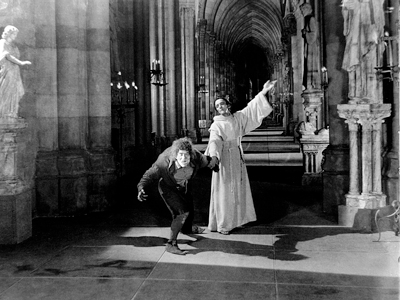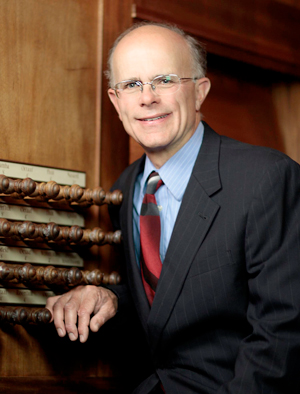by Timothy Robson

The film, based on Victor Hugo’s novel of the same title, is the tale of the deaf, half-blind and disfigured Quasimodo (Chaney) who lives in the vast spaces of Notre Dame Cathedral in 1482 Paris. The gypsy girl Esmeralda takes pity on Quasimodo after he has been beaten by a ruthless government official. The Captain of the Guard, Phoebus, is also smitten with Esmeralda, as are several less savory characters. The complicated plot is full of romance, betrayal, comedy and tragedy — everything a good movie should have. Although the acting style is now out of fashion, the movie’s subjects are as relevant in 2015 as they were in 1923.
Early theater organists would have assembled an accompaniment from a variety of sources including “canned” score sheets, often using popular themes of the day to represent the action and emotions of the emotions portrayed. Improvisation was an usually an essential element in the performance. Todd Wilson, Director of Music at Trinity Cathedral in Cleveland and a renowned concert organist, has in recent years resurrected the techniques of film accompaniment.
Prior to his performance on Friday night Wilson spoke briefly about the idea of having a set of predetermined themes from which to base his improvisations. He likened them to ingredients on the shelf that the cook can use as needed. He had invented a new theme in tribute to Gary Hanson, soon-to-retire Cleveland Orchestra Executive Director. The theme was created by musically “spelling” Hanson’s initials: GLH. The notes were G, D, and B-natural. During the film, this “special ingredient” was used mostly to accompany the hero Pheobus, often played on blazing trumpets.
As a prelude to the film, Todd Wilson played Marcel Dupré’s Cortège et Litanie using a lush registration that showed off the romantic sounds of of the Norton Memorial Organ built by E.M. Skinner in 1930 and reinstalled in 2000 as part of the renovation of Severance Hall. The Skinner organ is not in the style of a theater organ; it is a classical organ built in the “symphonic” style of its day. But it has a wealth of colors which Wilson used to full effect during the course of the movie’s almost two hour running time.
Todd Wilson played continuously through the whole film, with the exception of a few brief “grand pauses” for dramatic effect. The opening titles were underscored by perhaps the most famous organ work of them all: Bach’s Toccata and Fugue in d minor. But here, as elsewhere, Wilson was not satisfied to just play Bach’s music; the themes morphed into completely new music to follow the action. Many other themes — some familiar, some only slightly hinted at — abounded through the rest of the performance.

Among the tunes Wilson used for his kaleidoscopic improvisations were the French national anthem, the Marseillaise; the Dupré work played at the beginning; the Gregorian chant Ubi caritas (when Esmeralda takes pity on Quasimodo and gives him a drink of water, and other similar “selfless” moments); a fragment of Rachmaninov’s Symphonic Dances; Charles-Marie Widor’s Symphony No. 6; and the Gregorian chant for the dead, In paradisum. In one particularly humorous moment when a character is admiring a huge plate of food in Phoebus’s room, but is repeatedly stymied from eating it, the music was a fantasia on “Food, Glorious Food,” from the 1960s Broadway show Oliver. The film’s tragic ending was accompanied by very soft, haunting music, closing in silence. It was the perfect ending to an imaginative performance.
Lest this all seem like a gigantic, high-end game of “Name That Tune”, I can report that my guest for the evening, who is not a musician, was fascinated by the movie and the score. He wasn’t familiar with the tunes. And that is how it should be. Todd Wilson’s achievement — apart from the amazing physical stamina required to play non-stop for 110 minutes – was to blend recurring and evolving leitmotifs into an engaging and dramatic thread that captured every twist in the film’s convoluted plot.
Published on ClevelandClassical.com November 2, 2015.
Click here for a printable copy of this article



